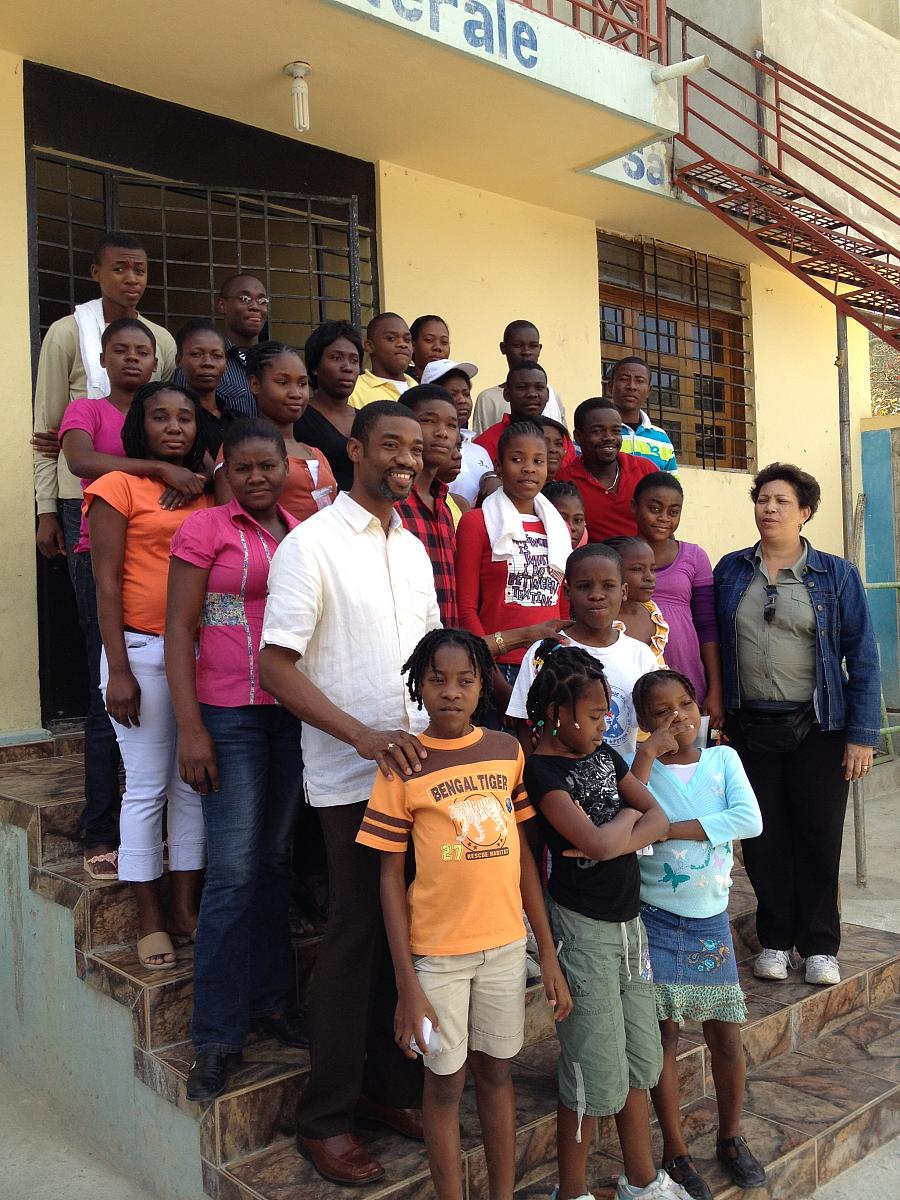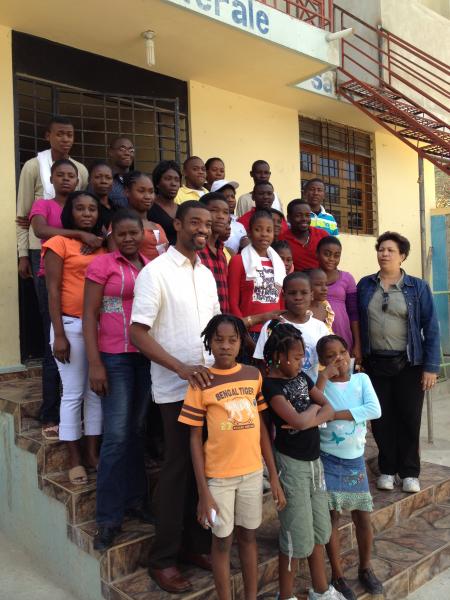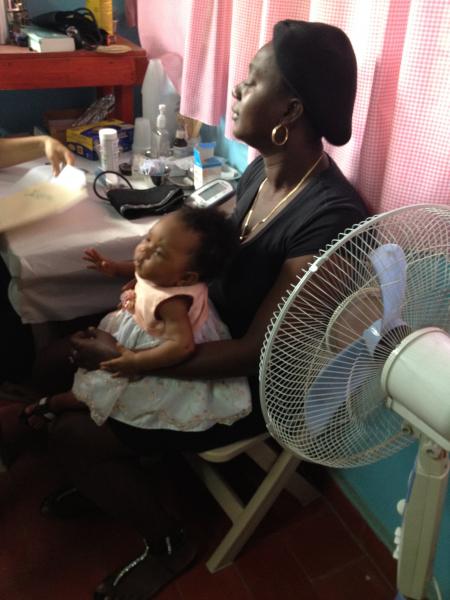At Haiti Diabetes Camp, Kids Learn to Live With Their Disease (And Not Much Else)

Editor's note: Noted diabetes specialist and Medtronic executive Francine Kaufman is in Haiti on a medical mission serving diabetic children. Here is her account of working at a diabetes camp that still struggles in the wake of the country's devastating earthquake.
 We are busy in Haiti. On Friday night, we left the diabetes camp at dusk – it is not safe to travel much after dark – just after the kids rambled off the bus and got settled in camp. Anxious to get back, we got up early Saturday morning and headed back up the mountain. Heading up this mountain in Haiti was like swimming against the current: broken down vehicles, chaos in the streets, pot holes as big as cars, and animals running free – mainly dogs and goats.
We are busy in Haiti. On Friday night, we left the diabetes camp at dusk – it is not safe to travel much after dark – just after the kids rambled off the bus and got settled in camp. Anxious to get back, we got up early Saturday morning and headed back up the mountain. Heading up this mountain in Haiti was like swimming against the current: broken down vehicles, chaos in the streets, pot holes as big as cars, and animals running free – mainly dogs and goats.
We were picked up by 81-year-old Charles Larco, the first endocrinologist in Haiti. He still is very involved in FHADIMAC, the Haitian Diabetes Association, which he and his amazing wife (well dressed, bouffant hair, and a forceful personality at 79 years of age) started. As we climbed the mountain, the clutch on his car stopped working. But as usual, we were being followed by a truck with our bodyguards and food for the camp, so we simply abandoned his car in the middle of the mountainous road, climbed into the truck and continued on to camp – leaving the bodyguards to figure out what to do with a car blocking half of the road.
We got to camp for morning blood testing and breakfast. To say that there was less than optimal control of glucose would be an understatement. Everyone is on 70/30 – a mixture of 70 units of NPH insulin and 30 units of regular insulin for every 1 ml of insulin. We haven't used this mixture since the mid-80s, and I wrote a paper on how it shouldn't be used in children. But nonetheless, we were helping decide insulin doses with an insulin preparation that actually doesn't really allow you to modify the regimen.
There actually were two young women, a teacher and a graphic designer, who had insulin pumps, but they were part of our staff and they spend part of their time in the United States and the Dominican Republic (which is supposed to be paradise compared to Haiti). After a breakfast during which more carbohydrates were consumed than we have seen in ages, we started our diabetes education program.
We stood in the middle of a classroom in what would have been condemned as a school at home and had a lively discussion about diabetes with the 27 campers. They knew many things, but had big holes in the bigger picture. There was one very verbal alpha male – smart, cunning and domineering – but also very endearing. He asked many questions and answered some himself. We drew many of the others in – many of them in their early 20s, and fewer under 10. The quietest were three girls, an 11-year-old and two 13-year-olds, all the size and maturity of seven- or eight-year-olds. They had huge livers, stiff joints (we have not seen this in 20 years in the United States), puffy faces and poor control of their diabetes.
There were two highlights of the day. We divided the campers into three teams and played Diabetes Jeopardy (they had never heard of Jeopardy). They were intensely competitive, the older kids brought in the younger ones, and they verbally fought with each other over whose answers were more correct. The biggest battle was over where one can inject insulin. The one group that said thigh, belly and arm argued that the two groups that said belly, arm and leg were wrong because you can't inject below the knee – which is still part of the leg. They were animated and excited, laughing and verbally battling. We have it all in our iPhone and Blackberry, and you don't have to understand Creole to understand the interaction.
But the best occurred when we had them draw what diabetes means to them and go around the room and show it. One of the normal sized 12 year old girl, diagnosed 6 months ago, drew a picture of a girl with a huge downturned mouth and tears streaming down her face. Candy was boxed out and broccoli was on the table. When she started to describe it, she burst into tears. No one made fun of her. The older boys chimed in how they cried – and many said they still do. The older girls told her it was okay to cry and that it gets better. They brought her into the group, and by the end of the session, she actually smiled for the first time.
We have appreciated that kids with diabetes around the world are the same...remarkably empathetic and caring...a wonderful "complication" of having diabetes. One of the incredible 20-year-old guys – he speaks near perfect English and is studying at the University said, "Having diabetes is like being a sunny day with the rain falling...it is bad but nature needs the rain."
 It was a full day. Three of the kids are orphans. Most don't have refrigerators. They skip insulin a lot if they think they aren't going to have food that morning or later that day. They live in the tents and horrible hovels throughout Port Au Prince and many have lost family members and friends in the earthquake. But they have ribbons in their hair, go to school or work and still somehow manage to deal with their diabetes as best they can with two strips a day to measure their glucose and an insulin preparation that should be banned for kids with type 1 diabetes but that's all they can get, and that's what keeps them alive.
It was a full day. Three of the kids are orphans. Most don't have refrigerators. They skip insulin a lot if they think they aren't going to have food that morning or later that day. They live in the tents and horrible hovels throughout Port Au Prince and many have lost family members and friends in the earthquake. But they have ribbons in their hair, go to school or work and still somehow manage to deal with their diabetes as best they can with two strips a day to measure their glucose and an insulin preparation that should be banned for kids with type 1 diabetes but that's all they can get, and that's what keeps them alive.
One girl told the story of being suspicious that she had diabetes when ants were found all over her urine (the sweetness from the sugar) and how she still sometimes sees if her blood sugar is high by peeing outside and seeing if the ants come to her urine.
As dusk was falling, we climbed back down the mountain and had dinner at the hotel where Merith is staying (and Mark and Carol who went off to their mountain village and will rejoin us after the weekend and after the camp). No one tried the goat dinner on the menu (we have yet to even consider any animal products), but while we were enjoying a group of Brazilians singing and playing guitar, water starting pouring out of the balcony surrounding the restaurant. A pipe burst, we didn't need to move, the Brazilians inched away and continued to play and the Haitians, at glacial speed, attended to the problem.
Today, we returned to camp first thing in the morning. In the middle of the night, one girl had a hypoglycemic coma (not one of these kids had ever done a middle of the night glucose, in fact few have ever checked at lunch or before bed since with their two strips a day. They check at breakfast and supper when they eat their main meals). The first activity was sex education for the older kids (and the two mothers, while the younger ones were whisked away for exercise), taught by a Haitian gynecologist friend of Nancy's. He showed pictures of real people with real sexually transmitted diseases, discussed HIV, STDs, and pregnancy, and safe sex. The kids asked a lot of questions, and when he discussed the risk of multiple partners, he asked what is meant by multiple partners. They said five, he said more than one.
This was followed by exercise, dancing, and school cleaning. I gave out the gifts from Medtronic, a little lion (our mascot) and coloring books and stickers. They all wanted them, even the older kids. Although it was Sunday, we went to church Saturday afternoon, so the kids didn't need to go today. However, the rest of the town descended on the chapel attached to the school that served as our camp, so we were surrounded in the chaos of cars as everyone tried to leave church at the same time. We reviewed all the blood sugar records. The typical pattern was that they came to camp with high levels. Many said they didn't take their shot that day because they weren't sure they would eat. Then they got normal or low as we gave them their "usual" doses. And then they bounced high – the rollercoaster of premixed insulin.
Then we went for mid-day meal – pumpkin chicken soup, bread and papaya. Neal felt horrible needing to ration the chicken so everyone got at least a small chicken leg, and since there was only enough for seconds for about half the kids, it was hard to decide who got it and who didn't. It was clear to us that many of these kids don't have the luxury of eating chicken often enough.
After they had two to three servings of soup (some of the kids took extra bread in their pockets), we went around the table and everyone said something, including the little ones, the one with developmental delay and the mothers, one of whom is illiterate. They stood up to speak (they always stand when they ask a question or make a comment) with confidence and style.
Even those who entered the camp appearing depressed or shy were now happy and outgoing. Camp is such a powerful experience for all involved. The thanks were profuse. Many of them said this was the best time of their lives, that they felt assured and less afraid, and even encouraged. Some of the younger ones said they didn't know you could live to be an adult if you were diagnosed as a child with diabetes. They all said they wanted to come back – and if possible, would prefer going to the Dominican Republic or any other country than Haiti. The gifted University student summed it up, "We can thank you a thousand times, but one should be enough because it is from our hearts."
Lots of hugs later, and the campers were gone. We went with Nancy, Phillipe, Evelyne, and Merith (plus Nancy's parents) to Nancy and Phillipe's house and for the first time we had a decent cup of tea. We had a meeting about future plans, you will all hear about them as they unfold – but needless to say, "We'll be back."
To thank us, the Larcos took us to an incredible mountain resort (don't forget we are in Haiti so don't get too excited) for a late afternoon meal. It was beautiful, but getting there was like a scary ride at Disneyland and getting back we ran into the Carnival that happens every Sunday leading up to Mardi Gras (or the Haitian equivalent). And now it's Super Bowl time, and our hotel lobby is filled with people.
One last comment – near our mountain lunch retreat was an orphanage. It is miles and miles away from the center of Port Au Prince and up a huge mountain. One of the orphans, a girl with developmental delay (who later got diabetes), walked there after the earthquake when she lost her parents and her house and had been living on the streets. How she found it, we will never know. But at least we do know where this girl ended up at the end of the day. Where the other campers went is totally beyond our comprehension - to tents, to partially collapsed houses, to the streets, to relatives or parents, we have no idea. Hopefully, wherever they are, maybe they can take a little bit better care of themselves.
Related Posts:
Diabetes in Post-Earthquake Haiti: An American Doctor's Experience
Photo credits: Francine Kaufman

